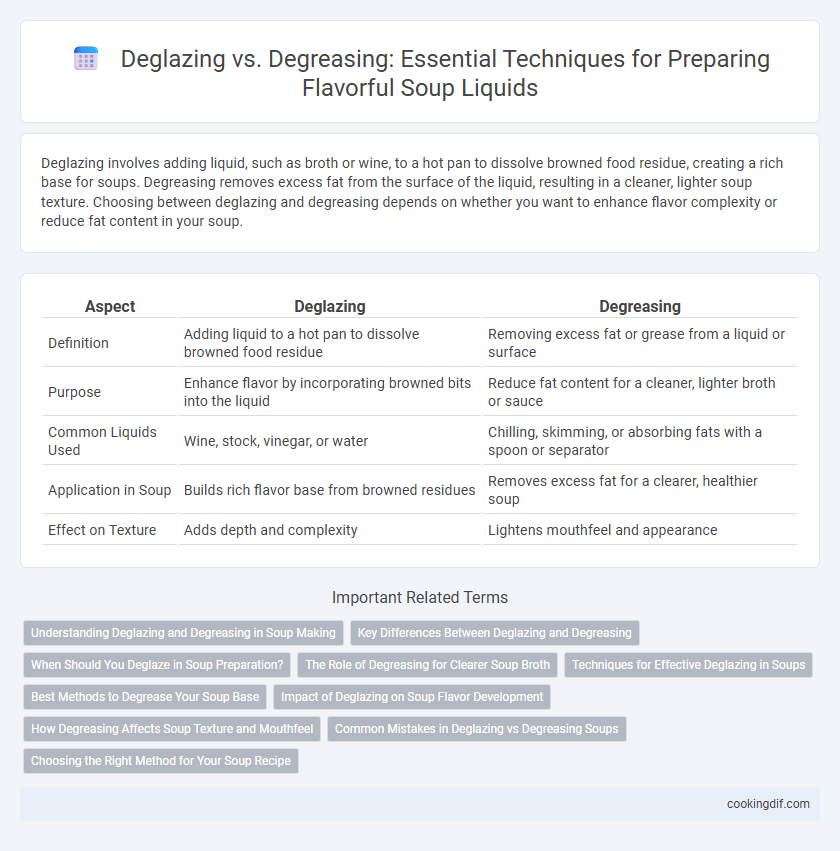Deglazing involves adding liquid, such as broth or wine, to a hot pan to dissolve browned food residue, creating a rich base for soups. Degreasing removes excess fat from the surface of the liquid, resulting in a cleaner, lighter soup texture. Choosing between deglazing and degreasing depends on whether you want to enhance flavor complexity or reduce fat content in your soup.
Table of Comparison
| Aspect | Deglazing | Degreasing |
|---|---|---|
| Definition | Adding liquid to a hot pan to dissolve browned food residue | Removing excess fat or grease from a liquid or surface |
| Purpose | Enhance flavor by incorporating browned bits into the liquid | Reduce fat content for a cleaner, lighter broth or sauce |
| Common Liquids Used | Wine, stock, vinegar, or water | Chilling, skimming, or absorbing fats with a spoon or separator |
| Application in Soup | Builds rich flavor base from browned residues | Removes excess fat for a clearer, healthier soup |
| Effect on Texture | Adds depth and complexity | Lightens mouthfeel and appearance |
Understanding Deglazing and Degreasing in Soup Making
Deglazing in soup making involves adding liquid, such as broth or wine, to a hot pan to dissolve browned food residues, enhancing the soup's depth of flavor through the incorporation of caramelized bits. Degreasing refers to the process of removing excess fat or oil from the surface of the soup, typically using a spoon or chilled fat separation techniques, to achieve a cleaner, lighter broth. Mastering these techniques ensures the final soup balances rich taste with a smooth, refined texture.
Key Differences Between Deglazing and Degreasing
Deglazing involves adding a liquid, such as broth or wine, to a hot pan to dissolve browned food residue, enhancing the soup's depth of flavor with caramelized bits, whereas degreasing focuses on removing excess fat from the soup's surface to improve clarity and reduce greasiness. Deglazing actively incorporates flavor compounds from the pan into the liquid base, while degreasing is a passive process aimed at improving texture and healthfulness by skimming or chilling to separate fat. Understanding these key differences helps achieve the desired soup consistency and flavor profile by either enriching the stock or cleaning the final presentation.
When Should You Deglaze in Soup Preparation?
Deglazing in soup preparation should be done immediately after sauteing ingredients like onions, garlic, or meat to dissolve the browned bits, known as fond, from the pan, which intensifies flavor. This process involves adding a liquid such as broth, wine, or water to lift these caramelized residues, enriching the soup's depth and complexity. Degreasing, by contrast, occurs later, removing excess fat from the surface to enhance clarity and reduce heaviness, making deglazing essential for foundational flavor development.
The Role of Degreasing for Clearer Soup Broth
Degreasing plays a crucial role in achieving a clearer soup broth by removing excess fat and impurities that rise to the surface during cooking. Unlike deglazing, which involves adding liquid to dissolve browned bits from the pan for added flavor, degreasing focuses solely on skimming or separating fat to enhance the broth's clarity and lightness. Effective degreasing results in a cleaner, more visually appealing soup with a refined taste and improved mouthfeel.
Techniques for Effective Deglazing in Soups
Deglazing in soup preparation involves adding liquid, such as broth or wine, to a hot pan to dissolve browned food residues, enhancing flavor complexity and depth. Effective deglazing requires selecting the right liquid temperature, typically warm to maintain cooking heat, and stirring promptly to lift fond without burning. This technique contrasts with degreasing, which focuses on removing excess fat and does not contribute to flavor development in the same manner.
Best Methods to Degrease Your Soup Base
Degreasing your soup base is most effective by chilling the soup to solidify the fat, then skimming it off with a spoon or using a fat separator to pour out the liquid while retaining the grease. Deglazing, on the other hand, involves adding liquid to a hot pan to dissolve browned bits, enhancing flavor but not reducing fat content. For lowering grease, techniques such as refrigeration and skimming are the best methods to maintain a clearer, healthier soup base.
Impact of Deglazing on Soup Flavor Development
Deglazing enhances soup flavor development by dissolving browned food residues from the pan, releasing complex Maillard reaction compounds that deepen taste and aroma. This technique introduces concentrated, caramelized notes, enriching the broth's umami profile and creating a more robust, layered flavor. Degreasing, in contrast, mainly removes excess fat without contributing to the savory depth that deglazing imparts.
How Degreasing Affects Soup Texture and Mouthfeel
Degreasing soup removes excess fat, resulting in a cleaner, lighter texture and a smoother mouthfeel that enhances delicate flavors. This process prevents heaviness and oiliness, making the soup more palatable and less greasy on the palate. Degreased soups often showcase a clearer broth, allowing underlying ingredients to shine without the interference of fatty residues.
Common Mistakes in Deglazing vs Degreasing Soups
Common mistakes in deglazing soups include using too little liquid or adding it at the wrong temperature, which prevents proper flavor extraction from browned bits. In contrast, degreasing errors often involve incomplete fat removal that results in greasy texture and overly rich taste, impacting soup clarity. Distinguishing between the two techniques ensures balanced, flavorful, and visually appealing soups.
Choosing the Right Method for Your Soup Recipe
Deglazing enhances soup flavor by dissolving browned bits from the pan using liquids like wine or broth, adding depth and complexity. Degreasing removes excess fat from the soup surface, improving clarity and reducing greasiness without altering the base flavor. Selecting deglazing boosts richness for hearty recipes, while degreasing suits lighter, clearer soups for a cleaner taste and presentation.
Deglazing vs Degreasing for liquid preparation Infographic

 cookingdif.com
cookingdif.com